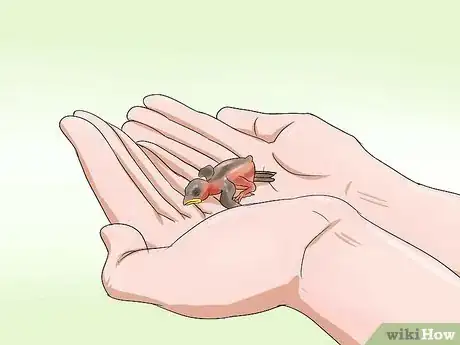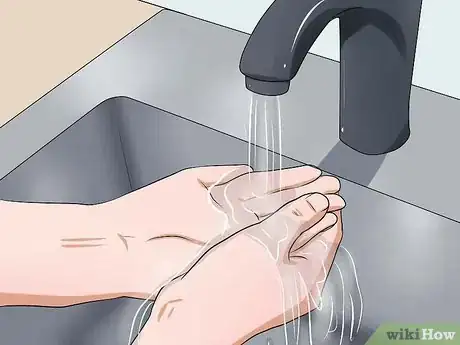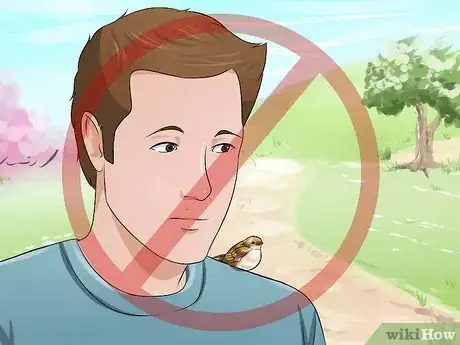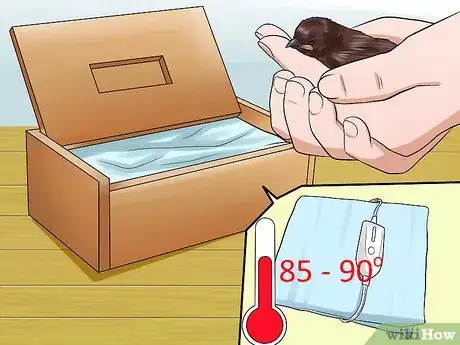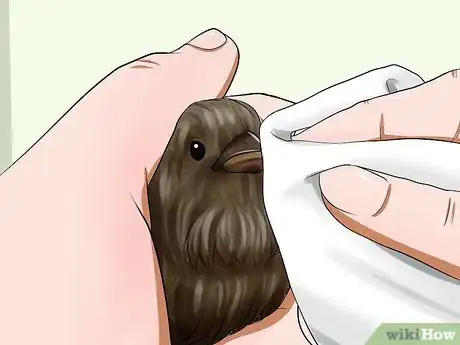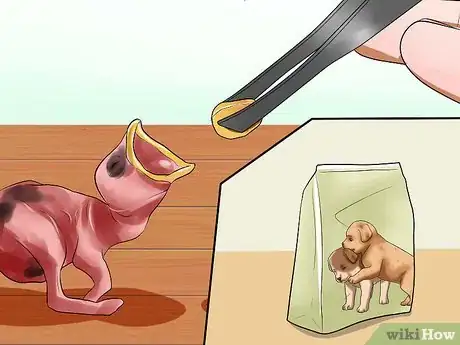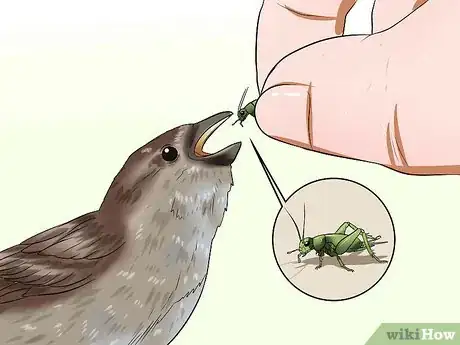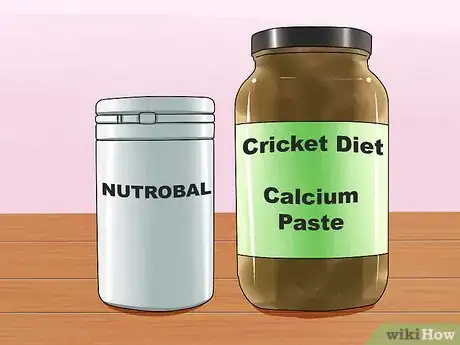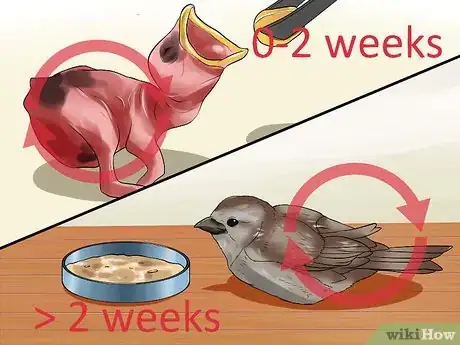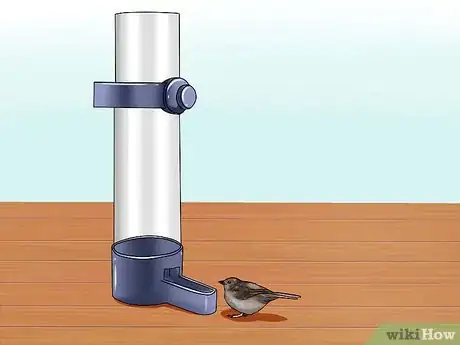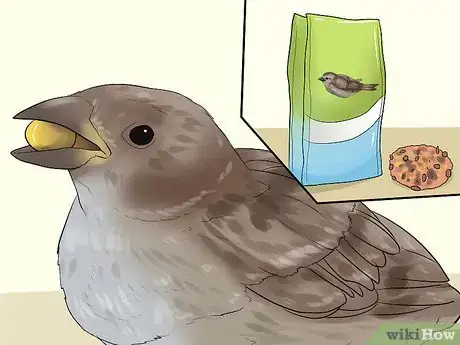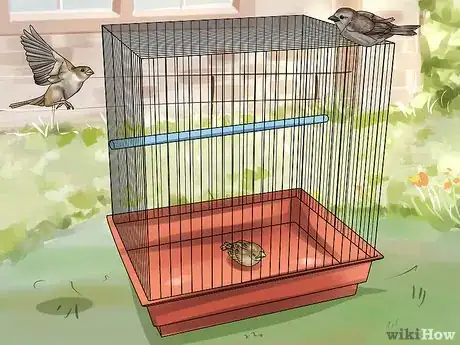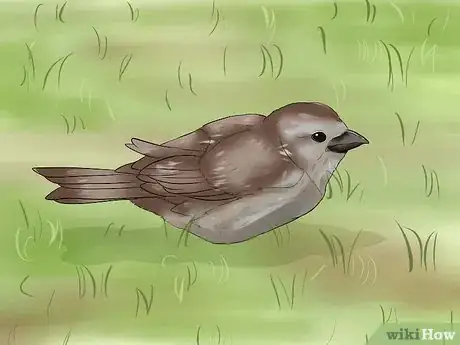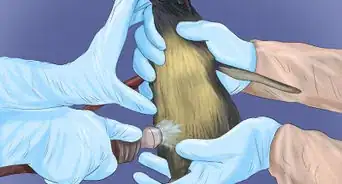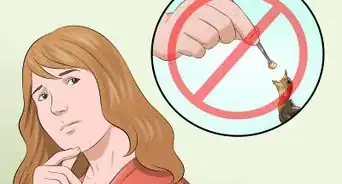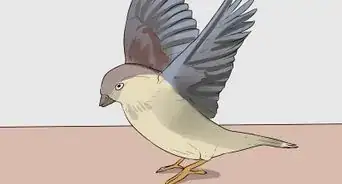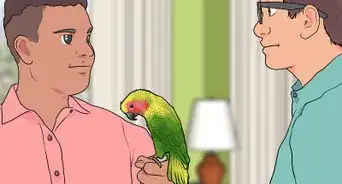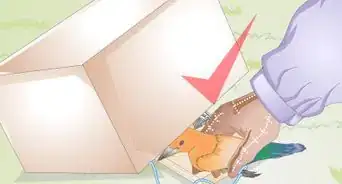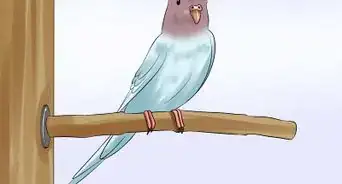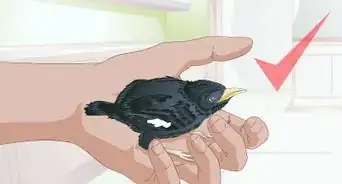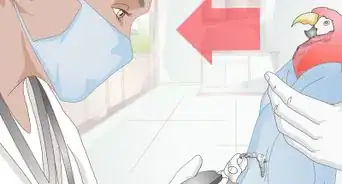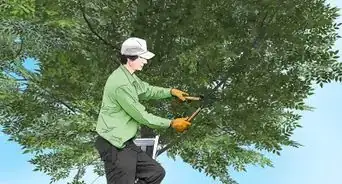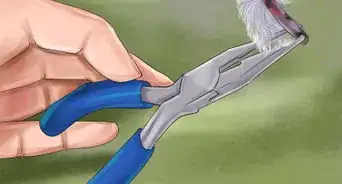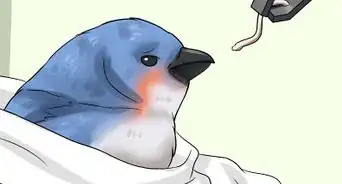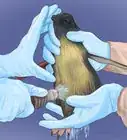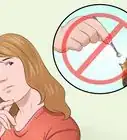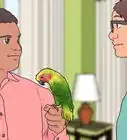This article was co-authored by Pippa Elliott, MRCVS. Dr. Elliott, BVMS, MRCVS is a veterinarian with over 30 years of experience in veterinary surgery and companion animal practice. She graduated from the University of Glasgow in 1987 with a degree in veterinary medicine and surgery. She has worked at the same animal clinic in her hometown for over 20 years.
wikiHow marks an article as reader-approved once it receives enough positive feedback. This article received 43 testimonials and 91% of readers who voted found it helpful, earning it our reader-approved status.
This article has been viewed 573,500 times.
If you've found a baby House Sparrow, you can learn how to care for it. However, before intervening, watch the area to make absolutely sure that the bird is an orphan. The mortality rates among hand-reared birds are high, so its best chance of survival is back in the nest under its parents' care.[1]
Steps
Avoiding Common Mistakes
-
1Make sure the bird is truly an orphan. If it has feathers, it is a fledgling and could be learning to fly. Therefore, it should remain on the ground - only remove it if it is in danger from a predator, or the parents do not return within one hour. If the bird has no feathers, it is a nestling, so look around to see if you can spot the nest. Gently pick him up and place him back in the nest.
- House Sparrows were originally recorded in Eurasia, North Africa, and the Middle East but now live all around the world. Because there are so many sparrows globally, they are not a protected species.[2] This means there are no laws prohibiting them being kept as pets.
-
2Protect your health when dealing with wildlife. It is not advisable for pregnant women or people with compromised immune systems to handle baby birds. They may carry diseases, such as salmonella, which can infect humans.
- Always observe strict hygiene when handling the bird. Thoroughly wash your hands before and after care. Dispose of waste in a sealed bag.
Advertisement -
3Avoid imprinting on the bird. If the bird has too much human contact, it may start to think you are its parent and will lose its fear of you. This makes it difficult to release the bird back into the wild. If your intention is to rear the bird to a stage when it is strong enough to be released, then avoid picking the bird up and handling it, especially during feeding. You want to retain the bird's natural fear of humans.
- Try to avoid the baby bird becoming imprinted on you. This means the bird assumes he is human rather than a bird and can lead to difficulties when releasing him back into the wild.[3]
- Do your best to avoid speaking to the bird. The goal should be to feed and care for the bird as if you are an "invisible force."
-
4Avoid giving the bird water. Nestlings and fledglings are fed on an all insect diet by their parents, and do not drink water. If you try to drip feed the bird water, you stand a good chance of it inhaling water and drowning.
Keeping a Baby House Sparrow Healthy
-
1Warm the bird. Put a heating pad set on low in a tissue box, and place some tissues in top of it. An alternative is to use a small bowl lined with paper towels. You can stand the bowl on a hot water bottle, or use an overhead heat lamp to keep the bird warm. Whichever you use, gently place the baby bird in it.
- The ideal temperature is 85- 90 F.
- Do not use terry clothes to line the nest as the claws and beak may become tangled to it.
- Put the nest in a dark, quiet place where it won't be disturbed by children or pets.
-
2Keep the bird's beak clean. After feeding, wipe the bird's beak and face clean with a disposable wet wipe or cotton wool soaked in water. A soiled beak area can lead to bacterial infections.[4]
-
3Measure the bird's progress. A Gram Scale may be used to measure the overall progress of your bird. Every day before you feed your bird, weigh it. A healthy baby bird should gain weight everyday.
- If your aim is to release the bird back into the wild, then consider not weighing the bird as the more contact you have, the more likely he is to imprint on you. If your intention is to raise the bird as a pet, then go ahead and weigh regularly to check progress.
Feeding a Baby House Sparrow
-
1Begin by feeding the baby bird puppy or cat food soaked in water. Add a baby bird formula or Pronutro to the water before mixing it into the food. Canned puppy or cat food has a higher protein content and are closer to the natural diet than adult dog food. Mash the food into a shallow bowl.
- If the bird is not old enough to feed itself, break off small pieces, about half the size of your little fingernail, and tweezer feed it by hand.
-
2Add as many bugs as possible to the puppy or cat food. Sparrow natural diet includes dry foods such as buds and seeds, and live food such as spiders, snails, aphids, caterpillars, and other small invertebrates. Young birds tend to take live food better than dry food.
- Please note, do not give earthworms to captive baby sparrows. There is something toxic about earthworms that makes captive birds die.[5] Instead, trying offering the smallest sized crickets (available from reptile supply shops).
- Another option is to offer clean white maggots, as sold by angling shops. Again, the maggot should only be fed when its gut is empty. The black line in a maggot his food in his gut, so wait until this black line disappears before feeding to the baby bird.
- You could also consider feeding dried insects, as sold for reptiles such as bearded dragons. Check your local pet store for supplies.
- If the sparrow is a nestling and not a fledgling, refrain from feeding it any insects and stick to the cat food diet. Insects such as flies can lead to fatal constipation in a young nestling.
-
3Dust all live foods with a vitamin and mineral supplement. You can use supplements such as Nutrobal (sold for reptiles) or Cricket Diet Calcium Paste (IZUG), which are sold at pet stores. This helps ensure balanced nutrition if the live food are deficient.
-
4Feed the bird often. Depending on the sparrow's age, either offer the food on tweezers directly into the gaping beak, or if the bird is old enough to feed himself, put the feed in a shallow container. Be aware it takes around 2 weeks for a baby bird to develop enough to feed himself.[6]
- If the bird is very young and does not have many feathers, feed every half hour. If older feed every hour or two. The bird will start chirping and gaping when hungry and will stop eating when full.
-
5Offer water, but only from a budgie sipper bottle. Young birds are not great at drinking from a shallow container. This is liable to cause accidental drowning.[7]
-
6Change the food you feed the bird as it gets bigger. As the baby grows older, continue to feed soaked dog or cat food but add a variety of different foods for the bird to choose from as well. A good quality wild bird seed is ideal as the bird matures enough to take grain of its own accord. Place the seed in a shallow bowl to allow the bird to start feeding when they are able.
- Keep the food clean of fecal soil, so clean the bowl at least once a day.
Preparing a Baby House Sparrow for Release
-
1Put the baby bird in a cage when it begins hopping. Begin leaving the cage outside during the day so other sparrows can visit. If you are avoiding close interaction with the bird and it is interacting with wild sparrows, then its chances of re-acclimating to the wild are much better.
- If the baby bird is not interacting with wild birds then it needs to learn the songs of its species another way. This will allow it to communicate with other birds when it is released. There are audio files available online that you can play for the bird.[8]
-
2Give the bird more and more time outdoors. Let it hop around on the grass after about 7-10 days old. If releasing the bird is your ultimate goal, try putting it in open space areas so they can learn to fly. Instinct will teach the bird to fly and discover what its wings are for.
- Wait until it has wing feathers, then if it doesn't seem to know what to do then its probably isn't ready. To test out whether he's ready, take him outside and place him on the ground in an area that's safe from predators.
- Leave the bird to its own devices for 20 minutes, if nothing happens bring it back indoors and try again another day.
-
3Make sure the bird is ready for release. If you're going to release it, make sure the baby can eat on its own. You also need to be sure that it is not imprinted on you.
- If the bird is imprinted on you, then it cannot be released into the wild. It needs to continue as a pet.[9]
Expert Q&A
Did you know you can get expert answers for this article?
Unlock expert answers by supporting wikiHow
-
QuestionWhen will the baby get its feathers?
 Pippa Elliott, MRCVSDr. Elliott, BVMS, MRCVS is a veterinarian with over 30 years of experience in veterinary surgery and companion animal practice. She graduated from the University of Glasgow in 1987 with a degree in veterinary medicine and surgery. She has worked at the same animal clinic in her hometown for over 20 years.
Pippa Elliott, MRCVSDr. Elliott, BVMS, MRCVS is a veterinarian with over 30 years of experience in veterinary surgery and companion animal practice. She graduated from the University of Glasgow in 1987 with a degree in veterinary medicine and surgery. She has worked at the same animal clinic in her hometown for over 20 years.
Veterinarian
-
QuestionI found a baby bird that can't fly. I can't keep it. What should I do?
 Pippa Elliott, MRCVSDr. Elliott, BVMS, MRCVS is a veterinarian with over 30 years of experience in veterinary surgery and companion animal practice. She graduated from the University of Glasgow in 1987 with a degree in veterinary medicine and surgery. She has worked at the same animal clinic in her hometown for over 20 years.
Pippa Elliott, MRCVSDr. Elliott, BVMS, MRCVS is a veterinarian with over 30 years of experience in veterinary surgery and companion animal practice. She graduated from the University of Glasgow in 1987 with a degree in veterinary medicine and surgery. She has worked at the same animal clinic in her hometown for over 20 years.
Veterinarian
Warnings
- Baby birds have a very small chance of survival. If your baby bird dies, it is not because you didn't try hard enough, it is simply because baby birds are supposed to be raised by their mom.⧼thumbs_response⧽
- Don't feed the bird earthworms, they carry diseases.⧼thumbs_response⧽
- Don't feed the bird upright water, as it can drown easily.⧼thumbs_response⧽
- Do not feed the bird milk at all. It will die of sour-crop!⧼thumbs_response⧽
Things You'll Need
- Cage
- Heating pad
- Tissues and tissue box, or a bowl and paper towels
- Cat or puppy food
- Baby bird formula
- Insects
- Bird seed
References
- ↑ Practical Wildlife Care. Lee Stocker. Publisher: Blackwell Science
- ↑ http://www.allaboutbirds.org/guide/House_Sparrow/lifehistory
- ↑ http://wildlifecenter.org/news_events/news/human-imprinting-birds-and-importance-surrogacy
- ↑ Practical Wildlife Care. Lee Stocker. Publisher: Blackwell Science
- ↑ Practical Wildlife Care. Lee Stocker. Publisher: Blackwell Science
- ↑ Practical Wildlife Care. Lee Stocker. Publisher: Blackwell Science
- ↑ Practical Wildlife Care. Lee Stocker. Publisher: Blackwell Science
- ↑ http://www.starlingtalk.com/babycare.htm
- ↑ http://www.starlingtalk.com/babycare.htm
About This Article
If you've found a baby house sparrow outside of its nest, leave it where it is and monitor it for a couple of hours to make sure its mother doesn't come back. Look for the mother circling overhead or watching from a distance. If the mother doesn't come back, put gloves on, carefully scoop the baby bird up, and place it in a cardboard box filled with cloth towels. If the baby bird doesn’t have feathers, set the box on a heating pad and turn it on to the lowest setting to keep the bird warm. Orphaned birds are often dehydrated, so use a dropper to pour some room temperature water on to the bird’s beak to give it something to drink. To feed the bird, mix some soft cat food with water. Use a clean dropper to carefully pour the cat food mixture into the baby bird’s mouth. Repeat this feeding and drinking process every 2 hours until the bird isn't interested in the food. Then, feed it once every 5-6 hours. Once the bird grows feathers and can fly or move around on its own, release it into the wild. If you can't raise the baby sparrow on your own, call a local wildlife refuge to pick the bird up and take care of it. For tips from our veterinary reviewer on preparing the baby bird for release, keep reading!
